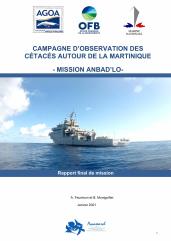Collaboration with the French Navy
The French Navy is present on all the seas of the world and is particularly demanding with regard to respecting the environment. Through the missions it carries out, it collects data and observations that can be used to achieve the Sanctuary's objectives of developing knowledge. It therefore seemed obvious that the French Navy and Agoa Sanctuary should join forces to coordinate their work.
Training volunteer sailors
In consultation with other marine protected areas in the West Indies, a training course for the onboard personnel of the French Navy initially planned for 2020 will take place in 2021. The aim is to obtain new observation data in areas that have not been surveyed or have been surveyed very little, especially the high sea. This training course is for volunteer sailors.
Onboard scientific missions
The French Navy has offered to provide high-sea resources to the French Biodiversity Agency (OFB) when it could be useful. In the West Indies, the overseas support and assistance vessel (BSAOM) Dumont D'Urville was made available to the Agoa Sanctuary and Martinique Natural Marine Park. The scientists of these two OFB units were therefore able to access areas which are usually inaccessible to them.
The first exploratory scientific mission in the West Indies, named An Ba D'Lo, took place in December 2020 in the French West Indies. For the Agoa Sanctuary, it was a great opportunity to enhance knowledge on the frequentation and use of the high-sea environment by cetaceans. Two members of the technical team were able to get onboard. To support them, the Sanctuary called upon the scientific experts from the Aquasearch environmental consultancy who carried out monitoring by visual observation as well as acoustic surveys by hydrophone.
Five species of cetaceans were observed: in the Caribbean Sea, the Pantropical Spotted Dolphin and the Short-finned Pilot Whale, and in the Atlantic, the Minke Whale, the Dwarf Sperm Whale and the Bottlenose Dolphin. On board, with the members of the Sanctuary's technical team, they were also able to raise awareness among a crew that was very interested in marine mammal conservation issues.
An Ba D'Lo has thus been an opportunity for rich exchanges between two institutions with different, yet linked perspectives.
The An Ba D'Lo mission was also an opportunity for OFB agents and scientists from the University of Western Brittany, the French National Museum of Natural History and UMR ISYEB (Institute of Systematics, Evolution, Biodiversity) to get nine environmental DNA samples from the ocean. This cutting-edge technique identifies species from the DNA they leave in their environment. By constantly interacting with each other and their environment, individuals can release cells in their secretions, in lost tissues or during cell renewal, for example.
During the mission, these genetic traces were collected by drawing and filtering sea water. As DNA is the universal carrier of genetic information, its analysis allow to detect the presence of these individuals and determine the species to which they belong. Currently being analysed by the SPYGEN laboratory, the samples have so far shown the presence of delphinids, but their species is yet to be determined.
In active service since 2020, the BSAOM Dumont D'Urville is the most recent patrol ship in the D'Entrecasteaux category. Based in Fort-de-France, it is 65 meters long and 14 meters wide. With a capacity of 24 sailors, this vessel can carry out a wide range of missions such as maritime surveillance, humanitarian assistance, interventions in the event of pollution at sea or even to combat drug trafficking.

Rapports de campagne An Ba D'Lo : transects et ADNe
Consultez les rapports de la mission An Ba D'Lo : observation scientifique par transects et ADNe.

A bord du Dumont D'Urville.
Olivier Nicolas/Marine Nationale/Armées
A bord du Dumont D'Urville.
Olivier Nicolas/Marine Nationale/Armées

A bord du Dumont D'Urville.
Olivier Nicolas/Marine Nationale/Armées
A bord du Dumont D'Urville.
Olivier Nicolas/Marine Nationale/Armées

Observation visuelle à bord du Dumont D'Urville.
Olivier Nicolas/Marine Nationale/Armées
Observation visuelle à bord du Dumont D'Urville.
Olivier Nicolas/Marine Nationale/Armées

Observation visuelle à bord du Dumont D'Urville.
Olivier Nicolas/Marine Nationale/Armées
Observation visuelle à bord du Dumont D'Urville.
Olivier Nicolas/Marine Nationale/Armées

Le Dumont D'Urville pendant la mission An Ba D'Lo.
Olivier Nicolas/Marine Nationale/Armées
Le Dumont D'Urville pendant la mission An Ba D'Lo.
Olivier Nicolas/Marine Nationale/Armées

Déploiement de l'hydrophone à bord du Dumont D'Urville.
Olivier Nicolas/Marine Nationale/Armées
Déploiement de l'hydrophone à bord du Dumont D'Urville.
Olivier Nicolas/Marine Nationale/Armées
Collaboration in the Pacific
The collaboration between the French Navy and the OFB is not limited to Martinique, since it is a national agreement. Echoing the An Ba D'Lo mission, the Kivi Kuaka expedition enabled eight scientists to embark on board the BSAOM Bougainville in late January 2021. This mission in the South Pacific consisted in observing the behaviour of migratory birds. The objective was to improve the ability of scientists and meteorologists to detect the formation and evolution of cyclones in order to anticipate natural disasters.
The partnership involved the Ministry of the Armed Forces, the National Museum of Natural History (MNHN), the Ministry of Ecological Transition (MTES), the French Development Agency (AFD), the French Biodiversity Agency (OFB) and Météo France.
Banner photo credit : Olivier Nicolas/Marine Nationale/Armées


